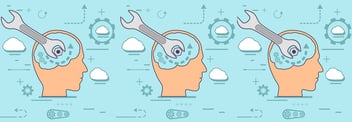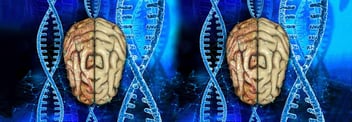DNA… Nurture Your Nature – Session Seven
- Home
- Blog

Alzheimer’s: Defend Against this Dreaded Disease
DNA+Environment+Triggers+Chance = Your Brain Health
Actionable DNA Testing Can Protect Against Brain-Ravaging– Bruce Alan Kehr, M.D.
Reader, have you ever had to admit you were wrong? It’s hard enough for one individual to do so–harder still for public figures, who are more and more frequently faced with whether or how to right a wrong policy, statement, or vote while in the public eye. In our contemporary era, when many of these public figures–especially politicians–have chosen instead to double down on their missteps and claim them as correct, it’s no surprise that many of us have become increasingly wary or skeptical of where the facts really lie–or whether truth exists at all. More and more we may wonder, when it comes to the public stage, “What is reality?” However, I’m happy to tell you that in one field, the field of scientific discovery, when new “realities” are discovered and are repeatedly and rigorously verified, they generally become accepted. Previously strongly held assumptions can shift. Even the firmest hypotheses regarding the nature of a disease or genetic mutation, or anything else about fundamental properties of the universe, will be modified when new information is provided. At times this may follow rigorous debate and fierce disagreement, but the “scientific method” generally wins out. When this happens, inevitably there are growing pains that accompany the construction of a more expansive or altogether new scientific principle—particularly for professionals, who must realign their outlook, but also for patients and their families, who sometimes are placed in a position where the new findings have come too late for them to reap the benefits. While this can be emotionally devastating for some (if my own father had lived another three years, the advent of newer cardiovascular drugs would have prolonged his life for decades) for others the future becomes clearer, brighter, and more hopeful. Such is the case today when it comes to preventing the progressive development of Alzheimer’s Disease.
How? In this blog series we have been focusing on a holistic view of health, underpinned by two key ideas: systems biology, which posits that the systems in our body, from our digestive tract to our heart to our brain, work together in undeniably complex ways, and “the whole is greater than the sum of the parts;” and epigenetics, which posits that changes to our lifestyle, eating habits, and more can in fact change how our cellular DNA expresses itself, leading to better (or worse) future health outcomes. The concepts underlying these two keywords are now widely accepted by the scientific community. But it wasn’t always that way. For many years, scientists took a more micro-focused approach to disease and pathology, trying, for instance, to pin unwieldy diseases down to a single source. Reader, our bodies don’t work that way. And the community was eventually presented with enough evidence and new facts that the perspective shifted. Nowhere is this shift more evident than in the understanding of disease progression in Alzheimer’s disease.
Last week, I introduced Alzheimer’s as the perfect example of how systems biology functions–if you recall, we discussed one of the basic “causes” of the disease–proteins embedded in the brain–and explored one newly discovered system, called the glymphatic system, our brain’s “sewer system” which seems to have a big role in flushing those bad proteins out of the brain. This week, we are going to dig deeper into how scientists once conceptualized the disease, why those perspectives are changing, and where the new facts seem to lead.
Alzheimer’s Disease: The Old School of Thought
It’s been understood for centuries, if not millennia, that both our bodies and our minds slowly degrade with age. But it has been science’s extraordinarily difficult task to determine the line between normal degradation of, say, basic cognitive functioning, and degradation that is excessive or pathological. It seemed that in this realm, some individuals did mentally decline to a far more drastic extent than others. In the early 1900s, one scientist discovered a common denominator in those who suffer more rapid decline: they all had excessive protein buildup in their brain cells, (in the form of amyloid β plaques). The scientist’s name was Alois Alzheimer, and with this discovery, the namesake disease was “born”.
Now, Alzheimer’s discovery was known as the Amyloid Hypothesis. It goes something like this: Alzheimer’s disease is exclusively brain oriented, neuronal, and uniformly linear, resulting from a linear accumulation of Amyloid β. The discovery also must be placed in the context of its times: scientific tools and methodology was rapidly modernizing in the early 20th century, leading many to drop previous descriptive methods and observations of a disease in favor of more mechanistic, microscopic view. Over and over, scientists found the Amyloid plaques. This was it, they thought. This was the cause of the disease.
But where did the proteins come from in the first place, and why were they getting stuck together in such a way that the brain could no longer function effectively? For nearly a century, many scientists simply never asked. Alzheimer’s was incurable and inevitable. All treatment would happen after the fact, and would be mainly palliative, slowing the progression somewhat or making it easier to bear.
If you’ve been following along with the series, perhaps you can infer why systems biology would test the Amyloid Hypothesis… and possibly either dismantle it or make it far more complex than it stands today. Why? Because systems biology is not about finding a single pinpointed cause. Our bodies and our minds simply don’t work that way. Rather, it’s about the elegant interplay between our genes, our environment, and our cellular biology… and when these factors are considered, the disease starts to look drastically different.
The Future of Alzheimer’s Disease Treatment
Much of my insights here are inspired by an extremely worthwhile scientific paper that came out in 2016 in Cell Magazine, by scientists Bart De Strooper and Eric Karran. The paper’s title is “The Cellular Phase of Alzheimer’s Disease” and its thesis may well be this single sentence: “In our view, AD only starts when a pathological cellular reaction is initiated.” In their view, Alzheimer’s is not something that spontaneously manifests, nor is it an inevitable consequence or development of an aging brain. Rather, they posit that the disease process begins decades before it is clinically diagnosed. As they note, when these harmful proteins first begin to generate, there is no evidence whatsoever that that process is not reversible. When that process begins, our bodies react in a similar manner to any other foreign body, such as an infectious agent (like a virus): we fight to regain homeostasis via inflammation (you may recall this process from Session 4). But as the authors state, “it is…when these compensating mechanisms turn into chronic, irreversible, and pathological process that disease progresses inexorably. The transition of an early reversible to a chronic, irreversible, autonomous cellular response, likely no longer dependent on the initial amyloid and Tau protein aggregate stressors represents a critical phase in the disease process.”
What might separate or protect our brains from the incubation phase, when those plaques are growing in our brains, and the later phase when the disease becomes irreversible? Systems biology and epigenetics provide the framework for a possible answer. As you read last week, one possibility may be the increased protection provided by our glymphatic system, the brain’s drainage system which rids it of many of the harmful toxins and waste-product buildup (other drainage comes from the brain’s blood vessel system, too). The glymphatic system does most of its work when we sleep. Certain genes can be “tweaked” (upregulated or downregulated) to help protect healthy glymphatic functioning. Another possibility may lie in the genes responsible for our inflammatory responses. Acute inflammation is a healthy and protective process in our bodies, but chronic inflammation, which you may see in the brain of someone who is incubating Alzheimer’s disease over time, can have a negative impact. As the authors state, “Recent genetic data unequivocally place inflammatory responses as being important in AD.” One gene in particular, TREM2, is related to inflammation processes and can have a rare mutation that significantly increases the chances of Alzheimer’s. Other genes contribute to increased risk as well (feel free to reference Figure 2 in the Cell article for a complete list). Is it possible that epigenetic modifiers might change these “risk” genes to something more normal or benign? TREM2, along with APOE4, ABCA7, CD33, and LRP1 are all tested in the Mindful DNA Assay, and help regulate glymphatic clearance of waste products, immune response/inflammation, and lipid metabolism in our brains. While variants of these genes may increase the risk of Alzheimer’s Disease, each gene has epigenetic modifiers associated with it that appear to reduce the risk of disease progression. These modifiers include supplements, diet, and other lifestyle modifiers that you can implement if you are at risk.
Nurture Your Nature… or Change It
There are multiple genes that may increase the risk of Amyloid accumulating over time, and determine how our brains respond to that development. Similarly, there are multiple systems, from sleep to inflammation to stress and even heart function, that all play a role in the risk of developing Alzheimer’s Disease. Scientists who believed this process to be inevitable and incurable have been wrong, plain and simple. But as new scientific discoveries come to light we are all rapidly changing our response to how we can manage, mitigate, and even prevent this disease. And as the authors of this paper state, “The major challenge for AD research is now to understand the complex cellular reaction underlying the prodromal phase of AD.”
The future is hopeful for those who may be at risk for Alzheimer’s. And it starts with the understanding that the power to change is often in our own hands–and in modifying the expression of our own genes.
Related Information
- Learn about Genetic Testing
- Learn about Potomac Psychiatry
- Meet Our Doctors
- Contact Potomac Psychiatry
.png?width=144&height=144&name=Untitled%20design%20(34).png)



